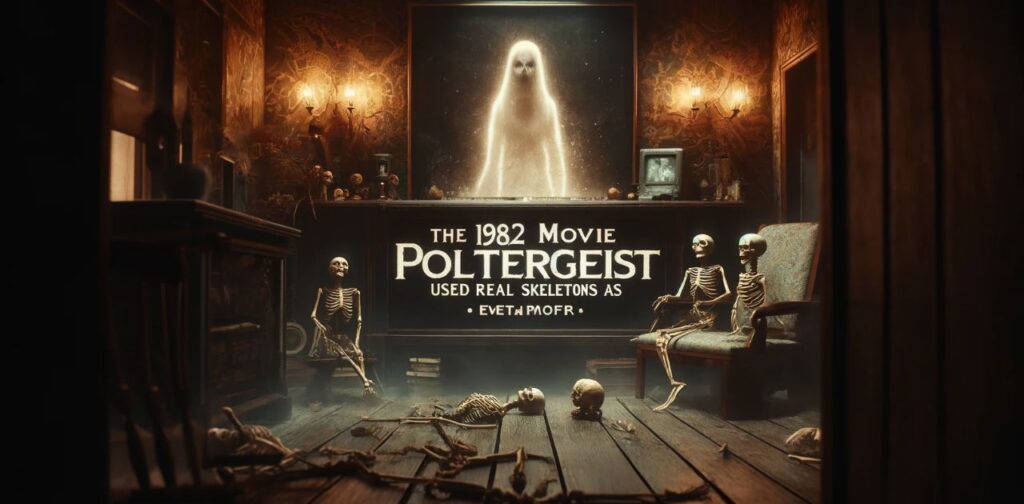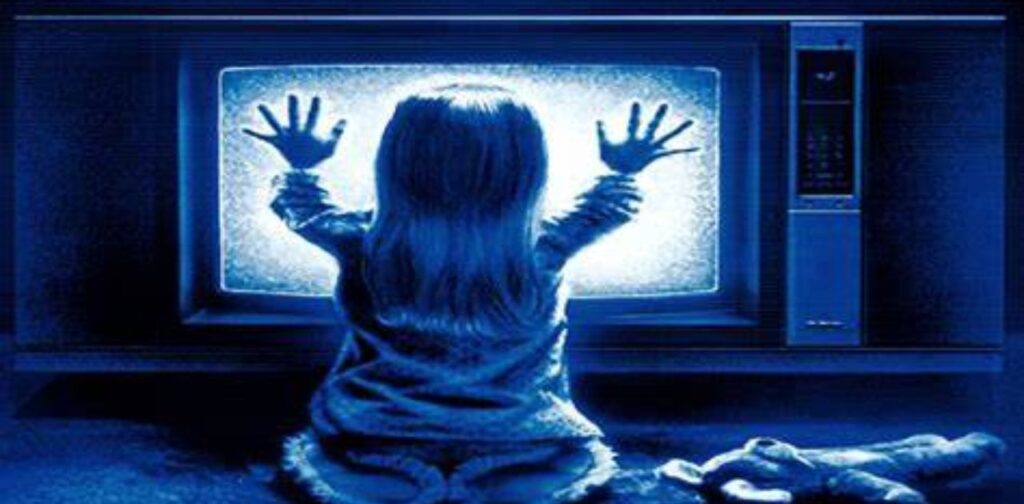In 1982, the horror film Poltergeist captivated audiences with its chilling supernatural scares and groundbreaking special effects. However, the real terror was happening behind the scenes – the filmmakers had made the disturbing decision to use real human skeletons as props throughout the production.
This shocking revelation, which surfaced years later, would go on to spark intense ethical debates within the film industry and leave a lasting impact on standards of filmmaking.
The Dark Cost-Cutting Measures of Poltergeist
When director Tobe Hooper and producer Steven Spielberg were bringing Poltergeist to life, they faced significant budget constraints. In an effort to cut costs, they opted for a controversial solution – acquiring genuine skeletal remains from medical supply companies instead of expensive prop skeletons.
As Hooper explained, “We wanted that raw, visceral quality that would really unsettle the audience. Using real skeletons was the best way to achieve that authentic horror we were going for.” This decision was primarily driven by financial considerations, as the genuine skeletal remains were considerably cheaper than crafting high-quality prop skeletons.
The filmmakers’ willingness to use real human bones to save money on their production highlights the challenges faced by many filmmakers, especially in the horror genre, where budgets can be tight and the pressure to deliver cutting-edge special effects is high. In their quest for realism and impact, Hooper and Spielberg made an ethically questionable choice that would haunt them for years to come.
The Source of Poltergeist’s Unsettling Props

The human skeletons used in Poltergeist were sourced from medical and educational suppliers, who typically obtained them from countries like India where the demand for prepared anatomical specimens was high. These skeletons were often considered surplus or unwanted, making them an attractive option for the film’s production team.
“It was deeply unsettling to know that we were handling actual human remains. As an actor, you’re trying to focus on your performance, but there was this underlying sense of discomfort about the ethics of it all.”
- JoBeth Williams, who played the character of Diane Freeling
The use of real human remains in filmmaking was not an uncommon practice at the time, as the entertainment industry often sought out cost-effective solutions for props and special effects. However, the Poltergeist production took this to an unsettling extreme, utilizing genuine skeletal remains that had once belonged to living, breathing individuals.
This raises profound questions about the ethical treatment of the dead and the boundaries that should be upheld, even in the pursuit of artistic expression and commercial success. The filmmakers’ decision to prioritize financial savings over more ethically sound alternatives would cast a long shadow over the production.
Moral Outrage and Industry Reckoning
When the use of real skeletons in Poltergeist was eventually revealed, it sparked immediate outrage and horror among the cast and crew, most of whom were unaware of the props’ true nature during filming. Actress JoBeth Williams, who portrayed the mother Diane Freeling, expressed her profound discomfort upon learning the truth.
“It was deeply unsettling to know that we were handling actual human remains,” Williams recalled. “As an actor, you’re trying to focus on your performance, but there was this underlying sense of discomfort about the ethics of it all.”
This controversy also prompted a broader reckoning within the film industry, forcing a reevaluation of ethical standards and practices surrounding the use of sensitive materials, especially in the horror genre. The backlash led to the implementation of new guidelines and regulations to prevent similar ethical lapses in the future.
One of the key impacts of the Poltergeist skeleton scandal was the increased scrutiny and oversight of prop sourcing and the use of human remains in filmmaking. Productions were now required to exercise greater due diligence, ensure the proper handling and disposal of such materials, and explore alternative, more ethical solutions when achieving desired special effects.
This industry-wide shift in attitudes and practices represented a crucial step forward in preserving the dignity of the dead and upholding the moral obligations of those working in the entertainment industry.
Spielberg’s Role and Responsibility
The involvement of Steven Spielberg, who served as a producer on Poltergeist, has been a subject of ongoing debate and speculation. While some insiders claim Spielberg was unaware of the specific details regarding the use of real skeletons, others suggest he was fully informed and approved the decision as a cost-saving measure.
Spielberg’s reputation as a visionary filmmaker and his commitment to ethical storytelling have led many to question his level of culpability in the Poltergeist skeleton controversy. As a prominent figure in the industry, his perceived role in sanctioning or turning a blind eye to the use of human remains has been a source of contention.
Some argue that Spielberg, as a producer with significant influence, should have exercised greater oversight and judgment to prevent such an ethical lapse. Others contend that the responsibility ultimately lies with the director, Tobe Hooper, who was directly responsible for the day-to-day production decisions.
Regardless of the specific details, the Poltergeist case has highlighted the need for greater accountability and transparency in the film industry, especially when it comes to the use of sensitive materials and the treatment of the deceased. As a respected industry leader, Spielberg’s response, or lack thereof, has been closely scrutinized by critics and the public alike.
Poltergeist’s Enduring “Curse”
The persistent rumors of a “curse” surrounding Poltergeist, marked by a series of tragic events involving the cast and crew, have only further fueled the public’s fascination with the film’s dark history. Some have speculated that the use of real human remains may have contributed to the alleged jinx, though the exact connections remain speculative.
The untimely deaths of young stars Heather O’Rourke and Dominique Dunne, as well as the various illnesses and misfortunes that befell other cast members, have all added to the film’s enduring legacy of darkness and misfortune. While the true causes of these events may be complex and multifaceted, the use of actual human skeletons has become inextricably linked to the Poltergeist “curse” in the public’s imagination.
This lingering sense of unease and superstition surrounding the film has only amplified the ethical concerns raised by the skeleton controversy. The idea that the disrespectful treatment of human remains could have had supernatural consequences has further cemented Poltergeist’s status as a cautionary tale in the annals of horror cinema.
Read Also: Catherine the Great Furniture: An Intriguing Journey into History
Ongoing Legacy and Ethical Discussions
The Poltergeist skeleton controversy remains a subject of ongoing debate and examination within the film industry and among cultural critics. The ethical implications of the filmmakers’ actions continue to be scrutinized, with many questioning whether the pursuit of cinematic realism and thrills can ever justify the use of human remains.
This case has become a touchstone for discussions about the moral boundaries of filmmaking, the need for greater transparency and accountability, and the responsibility that comes with wielding creative power. As the entertainment industry continues to push the boundaries of special effects and production value, the legacy of Poltergeist serves as a stark reminder that artistic vision must always be tempered by ethical considerations.
Key Facts:
- Poltergeist (1982) used real human skeletons as props during filming, a decision driven by cost-cutting measures
- The skeletons were sourced from medical and educational suppliers, often obtained from countries like India where the demand for prepared anatomical specimens was high
- The revelation of this practice sparked outrage and moral debates, leading to new industry standards and regulations surrounding the use of sensitive materials in filmmaking
- The Poltergeist “curse” and associated tragedies have further fueled the public’s fascination with the film’s dark history, with some speculating a connection to the use of real human remains
- This controversy remains a cautionary tale about the ethical responsibilities of filmmakers, even when pursuing artistic vision and commercial success
- The legacy of Poltergeist’s skeleton scandal continues to shape discussions about moral boundaries, transparency, and accountability in the entertainment industry
As the film industry continues to push creative boundaries, the legacy of Poltergeist’s skeleton scandal serves as a powerful reminder that moral considerations must always be at the forefront of production decisions. The pursuit of cinematic thrills can never come at the expense of human dignity and ethical integrity.
The Poltergeist case has left an indelible mark on the entertainment industry, inspiring a fundamental shift in the way filmmakers and producers approach the use of sensitive materials and the treatment of the deceased. It stands as a testament to the enduring power of ethical dilemmas to shape the evolution of creative practices and the responsibilities that come with wielding artistic influence.
Conclusion
In the end, the Poltergeist skeleton controversy serves as a sobering lesson – one that reminds us that the true horror in filmmaking can sometimes lurk behind the scenes, in the choices and compromises made by those tasked with bringing our nightmares to life.
As we continue to grapple with the ethical complexities of the entertainment industry, the legacy of Poltergeist will undoubtedly continue to loom large, a haunting reminder of the consequences that can arise when moral considerations are overshadowed by the pursuit of cinematic perfection.
Latest Article

Youthful insight with exceptional writing skills, delivering engaging and thought-provoking content.



